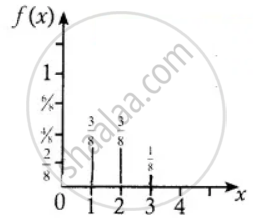Advertisements
Advertisements
प्रश्न
Three fair coins are tossed simultaneously. Find the probability mass function for a number of heads that occurred
उत्तर
When three coins are tossed, the sample space is
S = {HHH, HHT, HTH, HTT, THH, THT, TTH, TTT}
‘X’ is the random variable that denotes the number of heads.
∴ ‘X’ can take the values of 0, 1, 2 and 3
Sample space S = {HHH, HHT, HTH, THH, HTT, THT, TTH, TTT}
| Values of random variable | 0 | 1 | 2 | 3 | Total |
| Number of elements in inverse image | 1 | 3 | 3 | 1 | 8 |
Probability mass function
| x | 0 | 1 | 2 | 3 |
| f(x) = P(X = x) | `1/8` | `3/8` | `3/8` | `1/8` |
or
f(x) = `{{:(1/8, "for" x = 0",", 3),(3/8, "for" x = 1",", 2):}`
APPEARS IN
संबंधित प्रश्न
Suppose error involved in making a certain measurement is continuous r.v. X with p.d.f.
`"f(x)" = {("k"(4 - x^2) "for –2 ≤ x ≤ 2,"),(0 "otherwise".):}`
P(–1 < x < 1)
The following is the p.d.f. of continuous r.v.
f (x) = `x/8` , for 0 < x < 4 and = 0 otherwise.
Find F(x) at x = 0·5 , 1.7 and 5
Given the p.d.f. of a continuous r.v. X ,
f (x) = `x^2/3` , for –1 < x < 2 and = 0 otherwise
Determine c.d.f. of X hence find P(1 < x < 2)
Solve the following problem :
A player tosses two coins. He wins ₹ 10 if 2 heads appear, ₹ 5 if 1 head appears, and ₹ 2 if no head appears. Find the expected value and variance of winning amount.
It is felt that error in measurement of reaction temperature (in celsius) in an experiment is a continuous r.v. with p.d.f.
f(x) = `{(x^3/(64), "for" 0 ≤ x ≤ 4),(0, "otherwise."):}`
Find P(0 < X ≤ 1).
Solve the following problem :
Identify the random variable as discrete or continuous in each of the following. Identify its range if it is discrete.
An economist is interested in knowing the number of unemployed graduates in the town with a population of 1 lakh.
c.d.f. of a discrete random variable X is
A six sided die is marked ‘1’ on one face, ‘3’ on two of its faces, and ‘5’ on remaining three faces. The die is thrown twice. If X denotes the total score in two throws, find P(X ≥ 6)
Suppose a discrete random variable can only take the values 0, 1, and 2. The probability mass function is defined by
`f(x) = {{:((x^2 + 1)/k"," "for" x = 0"," 1"," 2),(0"," "otherwise"):}`
Find the value of k
Suppose a discrete random variable can only take the values 0, 1, and 2. The probability mass function is defined by
`f(x) = {{:((x^2 + 1)/k"," "for" x = 0"," 1"," 2),(0"," "otherwise"):}`
Find P(X ≥ 1)
The cumulative distribution function of a discrete random variable is given by
F(x) = `{{:(0, - oo < x < - 1),(0.15, - 1 ≤ x < 0),(0.35, 0 ≤ x < 1),(0.60, 1 ≤ x < 2),(0.85, 2 ≤ x < 3),(1, 3 ≤ x < oo):}`
Find P(X < 1)
A random variable X has the following probability mass function.
| x | 1 | 2 | 3 | 4 | 5 |
| F(x) | k2 | 2k2 | 3k2 | 2k | 3k |
Find the value of k
The cumulative distribution function of a discrete random variable is given by
F(x) = `{{:(0, "for" - oo < x < 0),(1/2, "for" 0 ≤ x < 1),(3/5, "for" 1 ≤ x < 2),(4/5, "for" 2 ≤ x < 4),(9/5, "for" 3 ≤ x < 4),(1, "for" ≤ x < oo):}`
Find P(X < 3)
The cumulative distribution function of a discrete random variable is given by
F(x) = `{{:(0, "for" - oo < x < 0),(1/2, "for" 0 ≤ x < 1),(3/5, "for" 1 ≤ x < 2),(4/5, "for" 2 ≤ x < 4),(9/5, "for" 3 ≤ x < 4),(1, "for" ≤ x < oo):}`
Find P(X ≥ 2)
Choose the correct alternative:
A pair of dice numbered 1, 2, 3, 4, 5, 6 of a six-sided die and 1, 2, 3, 4 of a four-sided die is rolled and the sum is determined. Let the random variable X denote this sum. Then the number of elements in the inverse image of 7 is
If the probability function of a random variable X is defined by P(X = k) = a`((k + 1)/2^k)` for k - 0, 1, 2, 3, 4, 5, then the probability that X takes a prime value is ______
For a random variable X, if Var (X) = 5 and E (X2) = 21, the value of E (X) is ______
Two cards are randomly drawn, with replacement. from a well shuffled deck of 52 playing cards. Find the probability distribution of the number of aces drawn.
